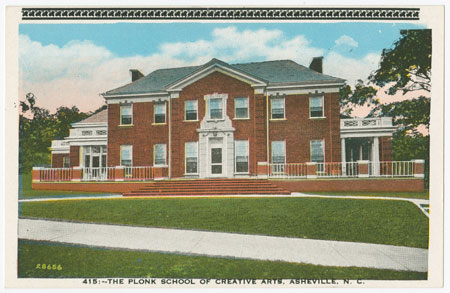
On Monday we added more than 300 postcards of Asheville to our North Carolina Postcards online collection. You’ll find some intriguing images of the Biltmore Estate and the Grove Park Inn. But the postcard that caught my attention is the one above. Mind you, I wasn’t drawn to it because of the photo. Rather it was the title that piqued my interest. Was the Plonk School of Creative Arts for kids? Or adults? What did they teach at such a school? What did the “creative arts” entail at the time the postcard was published?
The Plonk School of Creative Arts was the brainchild of sisters Laura and Lillian Plonk of Kings Mountain. According to a 1964 profile in The Asheville Times, Laura was a 1910 graduate of Lenoir-Rhyne College, did post-graduate work at the Boston School of Public Speaking and received a teacher’s diploma from the School of Expression, also in Boston. Her career included stints teaching speech in Kings Mountain and “oral English and Dramatics” at Wheaton College in Norton, Massachusetts and at Curry College in Boston.
As befitting someone with her education and experience, Laura Plonk placed a great emphasis on speech and drama at the Plonk School. The school’s 1961 catalog suggests that “all the faculties of a child or a young person–mind, body, voice, spirit–must be awakened, trained and directed before a well-provinced and a rich and distinctive personality can be compassed and achieved.” In addition to reading and basic math, preschool-aged children were tutored in speech, Dalcroze Eurythmics, group singing, poetry and French. Children in the primary grades continued studying all of the above and also had classes in “character and spiritual training” to help them with “better school and social behavior.” A similar curriculum was offered for junior high and high school students with the addition of classes in art, math, science and history (the full catalog is below).
One student of the Plonk School was writer Gail Godwin, who spent much of her youth in Asheville. In an interview with Asheville journalist Rob Neufield, Godwin relates that the fainting spells suffered by Jane in her novel The Odd Woman were based on her experiences at the Plonk School. The writer says she didn’t actually faint at the school.
What was true was, there was a school in Asheville called the Plonk School of Creative Art. It was run by two sisters, Laura and Lillian Plonk . . . I couldn’t stand it . . . For one thing, they tried to get our accents out of us so we wouldn’t speak like hillbillies. You’d have to say, “I never saw a purple cow.” Cow, not caih-ow.
Godwin’s mother, Kathleen, occasionally taught at the school. In a 1989 essay, the writer recalls that her mother “taught Drama or Poetry or Creative Writing, or whatever the autocratic Miss Laura Plonk, who thoroughly believed in Kathleen’s versatility, decided needed teaching that day.” Kathleen Godwin also taught at Asheville’s St. Genevieve’s Junior College, which had a grammar school tied to it. And it was to that school that the younger Godwin fled from the rigid speech lessons of the Plonk sisters.
The Plonk School began as the Southern Workshop, a program offered as a summer term in an Asheville public school in 1924. Five years later the sisters opened the Grove Park School. And in 1939, the Grove Park School and the Southern Workshop merged to become the Plonk School of Creative Arts. The school was at several sites. The building in the postcard above is at 1 Sunset Parkway. That site is now home to Zion Ministries Inc. We were unable to find a date for when the school closed. Laura Plonk died in March 1966 and Lillian died in June 1979.


